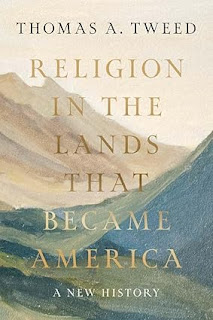 of Religion, he is editor of Retelling U.S. Religious History and author of Crossing and Dwelling: A Theory of Religion and Religion: A Very Short Introduction.
of Religion, he is editor of Retelling U.S. Religious History and author of Crossing and Dwelling: A Theory of Religion and Religion: A Very Short Introduction.
Tweed applied the “Page 99 Test” to his new book, Religion in the Lands That Became America: A New History, and shared the following:
Page 99 falls in chapter three, “Imperial Religion: Agricultural Metaphors, Catholic Missions, and the Second Sustainability Crisis, 1565-1756.” The preceding chapters chronicled religious history, from a rock shelter ritual in 9200 BCE attended by an ancient foraging community in present-day Texas to Christopher Columbus’s first encounters in 1492 with Taíno fishing-farming communities in the Caribbean. I set up the page 99 section about “Mexico and Peru” on the previous page, where I note that “the religious history of the Spanish colonies north of the Rio Grande starts in the Caribbean and Latin America, because that’s where the patterns were set that would shape the first settlements and missions in the lands that became the US.” Those patterns included importing enslaved Africans and displacing local Natives, as when Columbus, who returned in 1493, built a church cemetery on an earlier Taíno burial ground, thereby building the first colonial metropolis on “a Native necropolis.”Learn more about Religion in the Lands That Became America at the Yale University Press website.
Page 99 suggests that “Native maltreatment continued in the Aztec ceremonial center in the Valley of Mexico and the Incan ceremonial center in the Andes Mountains.” I describe a Spanish attack during an Aztec ceremony in Mexico City’s Great Temple in 1521, when, as a Native witness reported, “the blood flowed like water and gathered into pools.” I then note that some Spanish Catholic clerics in the Caribbean and Latin America protested the horrific maltreatment of Indigenous Peoples, as when one pious critic reported that “Christians grilled shamans until they ‘howled in agony.’” The protests reached Rome, where in 1537 the pope declared that Natives were “truly men” who should not be deprived of their liberty. I end the section with a comment: “It might seem astonishing that a church leader believed it necessary to declare Natives were human beings, but apparently it needed to be said.”
Ford Madox Ford’s Page 99 Test works well in at least two ways.
First, it shows how my account differs from the classic scholarly stories of American religion, which focused on theological ideas and Protestant churches and traced the rise and fall of Protestant public power. Page 99 illustrates the book’s animating aim—to craft a new plot by changing the story’s temporal span, spatial scope, and organizing themes. The page expands the geographical scope to Central and South America, just as earlier chapters had extended the chronological span to 11,100 years before the present. English Protestants, who are central characters in other stories, aren’t the focus on page 99, and, when they appear in the next chapter, the narrative doesn’t employ the usual motifs to recount a tale about the rise and fall of Protestant influence.
Second, the Page 99 Test offers a glimpse of the book’s main arguments—about “sustainability crises” and religion’s role. I chronicle three social and environmental crises in the lands that became America: the Cornfield Crisis (1140-1350), the Colonial Crisis (1565-1776), and the Industrial Crisis (1873-1920). The first crisis, discussed in the preceding chapter, was resolved as stressed farming communities moved away, scaled down, and reduced hierarchy. The other two crises remained unresolved and were bequeathed to subsequent generations. The Industrial Crisis is the topic of a later chapter, but the Colonial Crisis is introduced in the chapter that includes page 99: “As isolated settler outposts became interconnected imperial provinces a second crisis of sustainability flared up between 1650 and 1750, when empires’ emissaries sanctioned the displacement of Natives and the enslavement of Africans.” Page 99 includes details about the spiritually-sanctioned processes that, when redeployed north of the Rio Grande, generated socially and environmentally stressed niches like the slave plantation and the Indian reservation. Finally, page 99 identifies both atrocities and protests and, thereby, reinforces another of the book’s main points—that in the long history of the lands that became America religion both made things better and made things worse, sometimes inhibiting and sometimes promoting individual, communal, and environmental flourishing.
The Page 99 Test: America's Church.
--Marshal Zeringue



